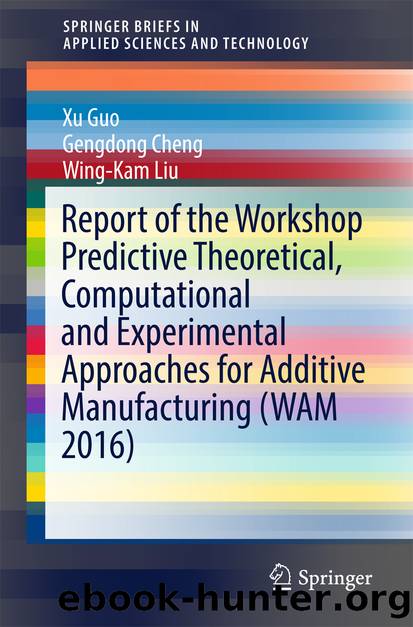Report of the Workshop Predictive Theoretical, Computational and Experimental Approaches for Additive Manufacturing (WAM 2016) by Xu Guo Gengdong Cheng & Wing-Kam Liu

Author:Xu Guo, Gengdong Cheng & Wing-Kam Liu
Language: eng
Format: epub
Publisher: Springer International Publishing, Cham
Prof. Han noted that AM is a big deal right now at the General Electric Company (GE). There are lots of news since mid-2011. He quoted some statements from GE, for example, âWithin our lifetime, at least 50% of the engine will be made by AMâ, âIn four decades, we could be printing the entire engineâ, and âComplexity is freeâ. For a LEAP fuel nozzle, only one part is manufactured by AM at GE, compared with the traditional manufacturing, which make it 25% lighter and 5x more durable.
Most people are focusing on material and process such as scan strategy, quantifying variability in AM components, and microstructure-aware modeling from materials processing to mechanical performance. However, Prof. Han stated that those are just evolution, not revolution, and that peopleâs thinking is still in traditional way. When talking about the differences between science and engineering, he raised some issues one should consider, including micro vs. meso vs. macro, material property vs. structure performance, manufacturing processed vs. structure design, and topology vs. sub-surface porous structure. He believes that the meso scale structure is important and simulation of additive design and manufacturing is interesting. He said that the game change includes integration of manufacturing process and field application and combining the modeling process with AM process, and that the behavior in the field application can be tracked back to the manufacturing. The innovation will include new finite element, supper element, implementing the parameters of manufacturing process, such as temperature, size and shape of melting pool, into intuitive equation, big data and knowledge enabling, as well as new methodology and standard for testing and validation, he said.
As for simulation of additive design and manufacturing, Prof. Han proposed some new ways of modeling. One is not dividing an existing structure into finite element but building up the structure by the same path as it is built from AM. Another one is not transferring an existing physical mode to math model but transferring both the physical mode and physical process together into a math model. He emphasized that model building process should be the same as the AM process.
Prof. Han commented that what people need for a structure are reliable design, reliable manufacturing, reliable analysis, reliable test, reliable validation, reliable safety, reliable dependability, and reliable cost. However, so far there have been no tools for design and analysis, no methods for test and validation, no standards for guideline and procedure, and no professionals in this prominent uncultivated land. To be one of the expeditions at Southern University of Science and Technology to explore the dream land, Prof. Han said, he and his collaborators are establishing a new discipline named as âSub-surface Fine Web Structure Engineering Mechanicsâ, as shown in Fig. 4.14. It is going to address all four topics of this workshop. Driven by the concrete requirements for a better aero engine, Prof. Han has tried to throw out a brick to attract a jade, as he added.
Fig. 4.14Need for a new discipline. Source Prof. Pinlian Han, Southern University of Science and Technology, presentation of Prof.
Download
This site does not store any files on its server. We only index and link to content provided by other sites. Please contact the content providers to delete copyright contents if any and email us, we'll remove relevant links or contents immediately.
| Applied | Geometry & Topology |
| History | Infinity |
| Mathematical Analysis | Matrices |
| Number Systems | Popular & Elementary |
| Pure Mathematics | Reference |
| Research | Study & Teaching |
| Transformations | Trigonometry |
Weapons of Math Destruction by Cathy O'Neil(5103)
Factfulness: Ten Reasons We're Wrong About the World – and Why Things Are Better Than You Think by Hans Rosling(4072)
Factfulness_Ten Reasons We're Wrong About the World_and Why Things Are Better Than You Think by Hans Rosling(2781)
Descartes' Error by Antonio Damasio(2778)
A Mind For Numbers: How to Excel at Math and Science (Even If You Flunked Algebra) by Barbara Oakley(2720)
TCP IP by Todd Lammle(2677)
Applied Predictive Modeling by Max Kuhn & Kjell Johnson(2521)
Fooled by Randomness: The Hidden Role of Chance in Life and in the Markets by Nassim Nicholas Taleb(2458)
The Tyranny of Metrics by Jerry Z. Muller(2443)
The Book of Numbers by Peter Bentley(2440)
The Great Unknown by Marcus du Sautoy(2216)
Once Upon an Algorithm by Martin Erwig(2169)
Easy Algebra Step-by-Step by Sandra Luna McCune(2157)
Practical Guide To Principal Component Methods in R (Multivariate Analysis Book 2) by Alboukadel Kassambara(2119)
Lady Luck by Kristen Ashley(2101)
Police Exams Prep 2018-2019 by Kaplan Test Prep(2066)
Linear Time-Invariant Systems, Behaviors and Modules by Ulrich Oberst & Martin Scheicher & Ingrid Scheicher(2004)
All Things Reconsidered by Bill Thompson III(1984)
Secrets of Creation, Volume 1: The Mystery of the Prime Numbers by Watkins Matthew(1895)
